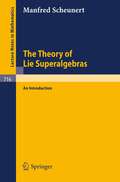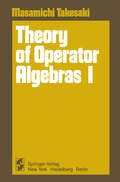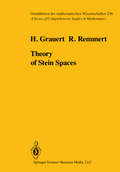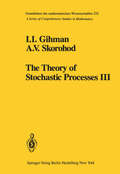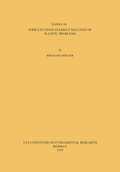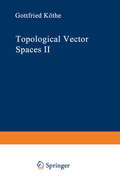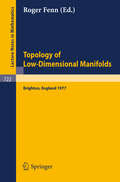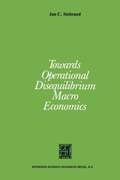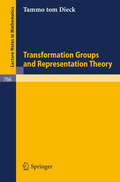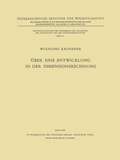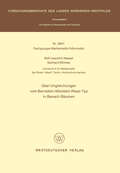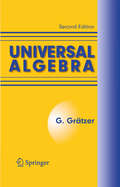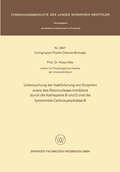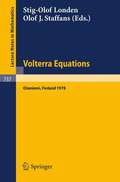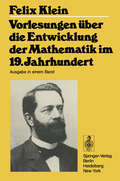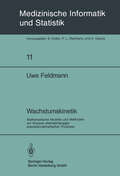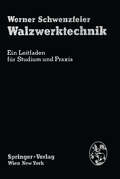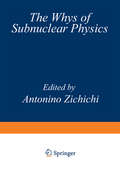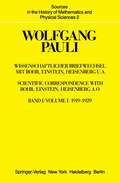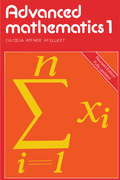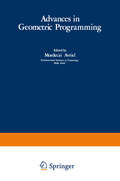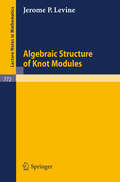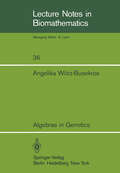- Table View
- List View
The Theory of Lie Superalgebras: An Introduction (Lecture Notes in Mathematics #716)
by M. ScheunertTheory of Operator Algebras I
by Masamichi TakesakiMathematics for infinite dimensional objects is becoming more and more important today both in theory and application. Rings of operators, renamed von Neumann algebras by J. Dixmier, were first introduced by J. von Neumann fifty years ago, 1929, in [254] with his grand aim of giving a sound founda tion to mathematical sciences of infinite nature. J. von Neumann and his collaborator F. J. Murray laid down the foundation for this new field of mathematics, operator algebras, in a series of papers, [240], [241], [242], [257] and [259], during the period of the 1930s and early in the 1940s. In the introduction to this series of investigations, they stated Their solution 1 {to the problems of understanding rings of operators) seems to be essential for the further advance of abstract operator theory in Hilbert space under several aspects. First, the formal calculus with operator-rings leads to them. Second, our attempts to generalize the theory of unitary group-representations essentially beyond their classical frame have always been blocked by the unsolved questions connected with these problems. Third, various aspects of the quantum mechanical formalism suggest strongly the elucidation of this subject. Fourth, the knowledge obtained in these investigations gives an approach to a class of abstract algebras without a finite basis, which seems to differ essentially from all types hitherto investigated. Since then there has appeared a large volume of literature, and a great deal of progress has been achieved by many mathematicians.
Theory of Stein Spaces (Grundlehren der mathematischen Wissenschaften #236)
by H. Grauert R. Remmert1. The classical theorem of Mittag-Leffler was generalized to the case of several complex variables by Cousin in 1895. In its one variable version this says that, if one prescribes the principal parts of a merom orphic function on a domain in the complex plane e, then there exists a meromorphic function defined on that domain having exactly those principal parts. Cousin and subsequent authors could only prove the analogous theorem in several variables for certain types of domains (e. g. product domains where each factor is a domain in the complex plane). In fact it turned out that this problem can not be solved on an arbitrary domain in em, m ~ 2. The best known example for this is a "notched" bicylinder in 2 2 e . This is obtained by removing the set { (z , z ) E e 11 z I ~ !, I z 1 ~ !}, from 1 2 1 2 2 the unit bicylinder, ~ :={(z , z ) E e llz1 < 1, lz1 < 1}. This domain D has 1 2 1 2 the property that every function holomorphic on D continues to a function holo morphic on the entire bicylinder. Such a phenomenon never occurs in the theory of one complex variable. In fact, given a domain G c e, there exist functions holomorphic on G which are singular at every boundary point of G.
The Theory of Stochastic Processes III (Grundlehren der mathematischen Wissenschaften #232)
by I. I. Gihman A. V. SkorohodTopological Vector Spaces II (Grundlehren der mathematischen Wissenschaften #237)
by Gottfried KötheIn the preface to Volume One I promised a second volume which would contain the theory of linear mappings and special classes of spaces im portant in analysis. It took me nearly twenty years to fulfill this promise, at least to some extent. To the six chapters of Volume One I added two new chapters, one on linear mappings and duality (Chapter Seven), the second on spaces of linear mappings (Chapter Eight). A glance at the Contents and the short introductions to the two new chapters will give a fair impression of the material included in this volume. I regret that I had to give up my intention to write a third chapter on nuclear spaces. It seemed impossible to include the recent deep results in this field without creating a great further delay. A substantial part of this book grew out of lectures I held at the Mathematics Department of the University of Maryland· during the academic years 1963-1964, 1967-1968, and 1971-1972. I would like to express my gratitude to my colleagues J. BRACE, S. GOLDBERG, J. HORVATH, and G. MALTESE for many stimulating and helpful discussions during these years. I am particularly indebted to H. JARCHOW (Ziirich) and D. KEIM (Frankfurt) for many suggestions and corrections. Both have read the whole manuscript. N. ADASCH (Frankfurt), V. EBERHARDT (Miinchen), H. MEISE (Diisseldorf), and R. HOLLSTEIN (Paderborn) helped with important observations.
Topology of Low-Dimensional Manifolds: Proceedings of the Second Sussex Conference, 1977 (Lecture Notes in Mathematics #722)
by R. FennTowards Operational Disequilibrium Macro Economics
by J.C. SiebrandMost re cent contributions to disequilibrium theory have a high level of abstraction. Empirical studies explicitly based on disequilibrium are still relatively scarce. However, empirical macro economics anticipated the theoretical development, and amalgamated classical and Keynesian elements often without a clear-cut formal base. Now a theoretical integration of neo-classical and neo-Keynesian economics seems under way. There is a renewed interest in the micro-economic foundations of macroeconomics with a special focus on the behaviour of economic agents operating in non-clearing markets. In some instances these theoretical developments offer an ex post justification for empirical macro-economic practices. Generally however, they call for new ways of empirical macro-economic model building. This study operates on the border line between empirical macro economics and theoretical disequilibrium macro-economic theory. Our interest in macro-economic disequilibrium originates from the empirical side. Foreign trade relations for several countries revealed significant pressure of demand effects. Hence, the spillover of excess demand in domestic markets to foreign markets seemed a rather general phenomenon. This fact could be explained by a theory that states that actual demand for products from domestic ftrms will gene rally and systematically differ from the ex ante demand as suggested by equilibrium analysis. This latter demand concept comes close to Clower's 'notional demand' and Patinkin's 'potential demand'.
Trioker mathematisch gespielt: Logik und Fantasie mit Dreiecken
by Marc Odier Y. Roussel2 Die 24 logischen Steine ........ . . . . .. . 11 3 Puzzles und Formen . . . . . . . . . . . .. . . . 12 . A Ganz einfache Puzzles . . . . . . . . . .. . . . 12 B Einfache Puzzles. . . . . . . . . . . . .. . . . 13 . C Schwierige Puzzles ................ 14 D Erste Puzzles mit 24 Steinen . . . . . . .. . . 15 E Eine erste Freiheit ................ 16 F Eine zweite Freiheit ............... 17 G Zwei Freiheiten gleichzeitig ........ 18 H Einschrankungen ................ 19 I Verfeinerte Einschrankungen ......... 20 K Einander erganzende Freiheiten und E- schrankungen . . . . . . . . . . . . . .. . . . 21 . . L Puzzles, die besonders schwierig sind ... 22 M Das Riesensechseck . . . . . . . . . . . .. . . 24 . 4 Gesellschaftsspiele .................. 25 A Einfache Spiele .................. 25 B Das symmetrische Duell. . . . . . . . . .. . . 27 C Spiel fiir N Spieler. . . . . . . . . . . .. . . . 30 . 5 Erste Ubungen und FragesteUungen . . . . .. . 32 A Zuerst einige Ubungen, die rasch erledigt sind . . . . . . . . . . . . . . . . . . .. . . 32 . . . . B Einiges zum Sechseck .............. 33 C Wozu die Gleichheit dient .......... 33 D Beschreibung der Steine durch Fra- spiele . . . . . . . . . . . . . . . . . .. . . . 34 . . . E Erste Zuordnungen . . . . . . . . . . . .. . . 36 . F Drei Pfeiltypen . . . . . . . . . . . . . . . 37 . . . G Zweier-Puzzles und ihre Darstellungen ... 38 H Dreier-Puzzles, Vierer-Puzzles, N-Puzzles . 42 6 Weitere Dberlegungen und Dbungen . . . . .. . 45 A Definition der Spielsteine . . . . . . . . .. . . 45 B Anzahl der Spielsteine . . . . . . . . . .. . . . 45 C Logische Anordnung der Spielsteine . . . .. 47 3 D Bezeichnung der Spielsteine . . . . . . .. . . 49 E Systematik der Puzzles zur Wiederholung 49 F Blumen mit der Zahl 3 . . . . . . . . . .. . . 53 . 7 Voll durchdachte Puzzlebeispiele . . . . . . .. . 55 A Logische Puzzles. . . . . . . . . . . . .. . . . 55 .
Über eine Entwicklung in der Dimensionsrechnung (Denkschriften der Österreichischen Akademie der Wissenschaften #116 / 9)
by W. KaunznerÜber Ungleichungen vom Bernstein-Nikolskii-Riesz-Typ in Banach Räumen (Forschungsberichte des Landes Nordrhein-Westfalen)
by Rolf Joachim NesselUniversal Algebra
by George GrätzerUniversal Algebra has become the most authoritative, consistently relied on text in a field with applications in other branches of algebra and other fields such as combinatorics, geometry, and computer science. Each chapter is followed by an extensive list of exercises and problems. The "state of the art" account also includes new appendices (with contributions from B. Jónsson, R. Quackenbush, W. Taylor, and G. Wenzel) and a well selected additional bibliography of over 1250 papers and books which makes this an indispensable new edition for students, faculty, and workers in the field.
Untersuchung der Inaktivierung von Enzymen sowie des Ribonuclease-Inhibitors durch die Kathepsine B und D und die lysosomale Carboxypeptidase B (Forschungsberichte des Landes Nordrhein-Westfalen #2847)
by Klaus OttoVolterra Equations: Proceedings of the Helsinki Symposium on Integral Equations, Otaniemi, Finland, August 11-14, 1978 (Lecture Notes in Mathematics #737)
by O. J. Staffans S. O. LondenVorlesungen über die Entwicklung der Mathematik im 19. Jahrhundert: Teil I (Grundlehren der mathematischen Wissenschaften #24/25)
by Felix KleinWachstumskinetik: Mathematische Modelle und Methoden zur Analyse altersabhängiger populationskinetischer Prozesse (Medizinische Informatik, Biometrie und Epidemiologie #11)
by U. FeldmannThe Whys of Subnuclear Physics (The Subnuclear Series #15)
by Antonio L. ZichichiFrom 23 July to 10 August 1977 a group of 125 physicists from 72 laboratories of 20 countries met in Erice to attend the 15th Course of the International School of Subnuclear Physics. The countries represented at the School were: Belgium, Bulgaria, Denmark, Federal Republic of Germany, Finland, France, Hungary, Ireland, Israel, Italy, Japan, the Netherlands, Norway, Poland, Sweden, Switzerland, the United Kingdom, the United States of America and Venezuela. The School was sponsored by the Italian Ministry of Public Education (MPI), the Italian Ministry of Scientific and Technologi cal Research (MRST) , the North Atlantic Treaty Organization (NATO), the Regional Sicilian Government (ERS) and the Heizmann Institute of Science. The School was very exciting due to the impressive number of frontier problems which were discussed. Being the 15th year of the School, it was decided to review all outstanding "Whys". At various stages of my work I have enjoyed the collaboration of many friends whose contributions have been extremely important for the School and are highly appreciated. I would like to thank Dr.A. Gabriele, Ms.S. McGarry, Mr. and Mrs. S. Newman, Ms.P. Savalli and Ms.M. Zaini for the general scientific and administrative work. Finally, I would like to thank most warmly all those ~n Erice, Bologna and Geneva who helped me on so many occasions and to whom I feel very much indebted.
Wissenschaftlicher Briefwechsel mit Bohr, Einstein, Heisenberg u.a.: Band 1: 1919–1929 (Sources in the History of Mathematics and Physical Sciences #2)
by Wolfgang PauliAdvances in Geometric Programming (Mathematical Concepts and Methods in Science and Engineering #21)
by Mordecai AvrielIn 1961, C. Zener, then Director of Science at Westinghouse Corpora tion, and a member of the U. S. National Academy of Sciences who has made important contributions to physics and engineering, published a short article in the Proceedings of the National Academy of Sciences entitled" A Mathe matical Aid in Optimizing Engineering Design. " In this article Zener considered the problem of finding an optimal engineering design that can often be expressed as the problem of minimizing a numerical cost function, termed a "generalized polynomial," consisting of a sum of terms, where each term is a product of a positive constant and the design variables, raised to arbitrary powers. He observed that if the number of terms exceeds the number of variables by one, the optimal values of the design variables can be easily found by solving a set of linear equations. Furthermore, certain invariances of the relative contribution of each term to the total cost can be deduced. The mathematical intricacies in Zener's method soon raised the curiosity of R. J. Duffin, the distinguished mathematician from Carnegie Mellon University who joined forces with Zener in laying the rigorous mathematical foundations of optimizing generalized polynomials. Interes tingly, the investigation of optimality conditions and properties of the optimal solutions in such problems were carried out by Duffin and Zener with the aid of inequalities, rather than the more common approach of the Kuhn-Tucker theory.
Algebras in Genetics (Lecture Notes in Biomathematics #36)
by Angelika Wörz-BusekrosThe purpose of these notes is to give a rather complete presentation of the mathematical theory of algebras in genetics and to discuss in detail many applications to concrete genetic situations. Historically, the subject has its origin in several papers of Etherington in 1939- 1941. Fundamental contributions have been given by Schafer, Gonshor, Holgate, Reiers¢l, Heuch, and Abraham. At the moment there exist about forty papers in this field, one survey article by Monique Bertrand from 1966 based on four papers of Etherington, a paper by Schafer and Gonshor's first paper. Furthermore Ballonoff in the third section of his book "Genetics and Social Structure" has included four papers by Etherington and Reiers¢l's paper. Apparently a complete review, in par ticular one comprising more recent results was lacking, and it was difficult for students to enter this field of research. I started to write these notes in spring 1978. A first german version was finished at the end of that year. Further revision and translation required another year. I hope that the notes in their present state provide a reasonable review and that they will facilitate access to this field. I am especially grateful to Professor K. -P. Hadeler and Professor P. Holgate for reading the manuscript and giving essential comments to all versions of the text. I am also very grateful to Dr. I. Heuch for many discussions during and after his stay in TUbingen. I wish to thank Dr. V. M.
